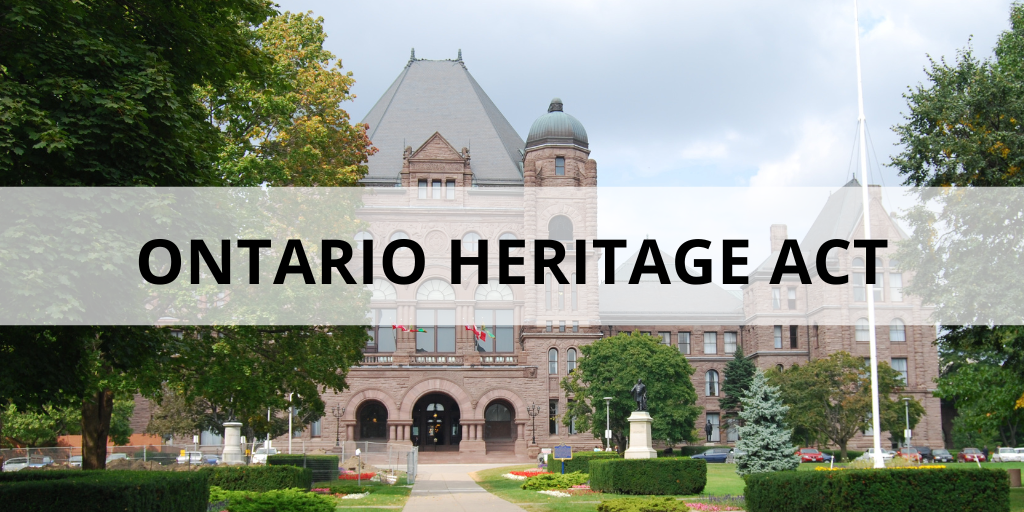Bill 23, More Homes Built Faster Act, 2022 guts out key heritage protection tools in the Ontario Heritage Act.
The Ontario Government’s More Homes Built Faster Act (Bill 23) – spun as being essential to slash through “red tape” in 10 existing Provincial Acts and create 1.5 million new Ontario homes in 10 years – was rushed into law on November 28 after a month’s consideration and almost no public consultation. This sprawling Act contains changes that gut out key heritage protection tools in the Ontario Heritage Act, including:
- Making heritage designation much harder, especially jeopardizing protection of places important to Indigenous and underrepresented communities;
- Choking off the protection of undesignated places with “heritage potential” by imposing a two-year limit on their listing on municipal Heritage Registers (currently containing over 31,500 properties province-wide);
- Making Heritage Conservation Districts harder to designate, and easier to repeal;
- Prohibiting heritage designation once a planning application has been made, putting cultural heritage resources at high risk of loss; and
- Risking the natural environment and cultural heritage of the traditional territories of Indigenous communities, and not adequately consulting with, and accommodating the concerns of, First Nations as Inherent and Treaty Rightsholders.
The new Act also strikes devastating blows to natural heritage conservation in Ontario – such as opening-up the Ontario Greenbelt around Toronto (the world’s largest urban greenbelt protecting 2 million acres of farmland, forests, wetlands, rivers and lakes) to housing development – and has drawn sharp rebukes from stakeholders as diverse as the Chiefs of Ontario, Environmental Defence, Ontario Nature, Ontario Business Improvement Area Association, and Association of Municipalities Ontario. ACORN Canada and affordable housing advocates warn the Act will deepen the current housing crisis by stripping away municipal powers to protect existing affordable housing.
Why it matters:
Risk of more demolition and waste of cultural heritage, viable older buildings, and valuable construction materials: Provincial-territorial heritage legislation is the bedrock of heritage conservation in Canada, and in Ontario, the Ontario Heritage Act stands as the only bulwark for sober second thought before demolition, which is granted “as a right” to property owners. Under the Ontario Building Code Act, the only buildings in the province requiring notice of a demolition application are on properties listed or designated under the Ontario Heritage Act. Shamefully, Canada leads the world in landfill per capita (an annual 36.1 metric tons per person) with demolition and construction materials at least 30% of that waste stream.
This stands in stark contrast to Europe and the UK where an active transition from a take-make-waste linear economy to a reuse-oriented circular one is underway, including instituting demolition justification requirements and, when necessary, building deconstruction (careful harvesting of building materials) to reduce the construction industry’s massive environmental impact. New construction – including the extraction/fabrication of new building materials – accounts for over 11% of global GHG emission.
Undermining the rights of municipalities and citizens: The Ontario Heritage Act was brought into law in 1975 “to give municipalities and the provincial government powers to preserve the heritage of Ontario.” A core principle of the Act was that local citizens, though their city councillors, know best which heritage was important to be identified, protected, and preserved in their communities. When the Act was updated in 2005, a key part was to formalize the Heritage Register to enable municipalities to publicly identify designated heritage places as well as “listing” those with heritage potential (and providing a 60-day pause before issuing a demolition permit).
Creating barriers to the retention of diverse heritage places: In recent decades, the understanding of what constitutes a heritage place has expanded beyond grand buildings and solely historical and aesthetic considerations, to encompass Indigenous cultural landscapes, and other places that may not satisfy traditional criteria for designation – such as modest collections of structures associated with the diversity of Canada.
Robust heritage resources inventories serve as a basic building block of any local/provincial-territorial heritage conservation program and are an internationally recognized best practice. It is interesting to note that Quebec’s Bill 69, An Act to amend the Cultural Heritage Act (2021) underscores the importance of this approach, now requiring municipalities to create robust registers of potential heritage properties in their jurisdictions.
What needs to change:
Housing is a urgent priority and heritage conservation is an ally for those truly seeking to create more housing, minimize environmental impact, and build resilient communities. Heritage conservation supports thoughtful intensification, including well-designed and planned infill as well as the conversion and rehabilitation of existing buildings as housing. Substantial evidence from across Ontario shows that heritage conservation and housing development are mutually beneficial and not in opposition to each other as the More Homes Built Faster Act (and the 2022 Report of the Ontario Housing Affordable Task Force that proceeded it) take as a given.
Ironically, the Act is focussed on clearing the way to new construction but fails to address inherent systemic barriers to building reuse, which if removed would both create housing faster and eliminate the additional carbon footprint associated with new construction. Building code conflicts, a lack of skilled trades, and tax system distortions currently impede the adaptive reuse of Ontario’s existing buildings but are not addressed by measures in the Act.
We urge the Government of Ontario to undertake further review of the implications of the proposed amendments to the Ontario Heritage Act prior to proclamation. Urgent consultation with provincial heritage organizations and other stakeholders and rightsholders is needed to remove or mitigate these harmful changes to the Ontario Heritage Act.
We urge heritage advocates to continue to build relationships and understanding with others who share the goal of caring for people, places and the planet, and rebalancing a development industry skewed toward new construction, not maximizing building lifespans and adaptive reuse.
Location: Ontario
Endangered Places List: 2022
Status: Endangered

